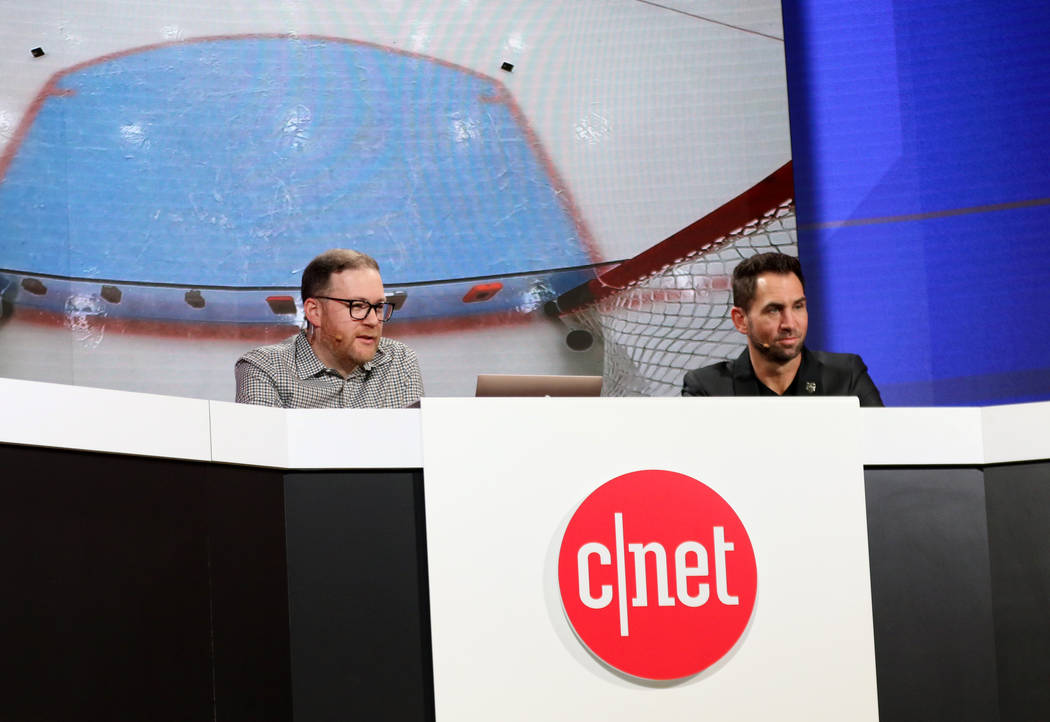Golden Knights’ Shane Hnidy breaks things at CES
Most first-time CES visitors hit the convention floor with their sights set on experiencing the latest and greatest gadgets ready to hit the market.
Golden Knights broadcaster Shane Hnidy was there to help break stuff.
The former NHL defenseman participated in CNET’s torture test in a pretaped segment unveiled Wednesday in front of an audience at the Sands Expo and Convention Center.
“We kind of knew there were no products that would survive,” Hnidy said. “But it was a lot of fun.”
The exercise was filmed Monday at City National Arena. Hnidy and CNET editor-at-large Jeff Bakalar, a self-proclaimed beer league hockey player and New Jersey Devils fan, lined up digital cameras, a thermal phone, a rugged phone case and a GoPro in the net and took aim with slap shots and wrist shots.
After first trying to tie the items to a plastic strip on the ice, Hnidy suggested hanging them from the crossbar.
Eventually, the giddy duo devolved to just using the contraptions as pucks.
The result was a heap of shattered glass and broken plastic.
“In no way should we expect any of these gadgets to survive what we did to them,” Bakalar said of what was more a game than any sort of product experimentation.
Hnidy, who played 11 seasons in the NHL, knows how much damage the puck can do.
“The average speed of a slap shot is 85 to 90 mph,” he said. “The hardest ever recorded was 108.8 by Zdeno Chara. You use a 6-ounce vulcanized rubber puck that’s prefrozen and travels at speeds similar to a baseball, but there’s 20 percent more kinetic energy to a hockey puck traveling the same speed and it causes extremely more damage.
“I’ve broken bones through that equipment from blocking a puck. I almost lost my eye twice from a hockey puck. It’s very dangerous. We put these devices through what a lot of guys get injured from.”
While Hnidy was at ease rattling off the data, he said he’s not much of a tech guy.
“I hate to say it, but maybe I’m getting old,” he said. “I’ve got to update myself, but it’s so cool to see all these things being invented and all the ideas out there. It’s kind of overwhelming right now.”
It’s not as if he’s averse to new ideas.
While Hnidy calls himself more of an “old-school” guy in general, he has embraced the technological revolution coming to the hockey world.
Progress was once seen as taking hockey equipment from the old days of the wooden stick to the current composites of Kevlar and carbon fiber. Now the possibilities are endless.
“I know the NHL is about to really advance the technology in the game to follow puck and player tracking,” Hnidy said. “Hopefully, that will come soon because hockey is a unique sport to try to track because it’s so fast and there’s no downtime because players change during play. I’m excited for that. It will really help us as broadcasters to give all that data and information to viewers and people interested in the game during play.”
That includes everything from real-time data on the top speed a player reaches on a breakaway or the velocity on a slap shot.
“We’ll get analysis on how accurate the team is passing and how far each player has skated,” Hnidy said. “They’re even coming up with ways to test players’ minds.
“It’s so interesting to follow how quickly things move and how it’s going to come into the game at the highest levels.”
The Review-Journal is owned by the family of Las Vegas Sands Corp. Chairman and CEO Sheldon Adelson.
Contact Adam Hill at ahill@reviewjournal.com. Follow @AdamHillLVRJ on Twitter.

























